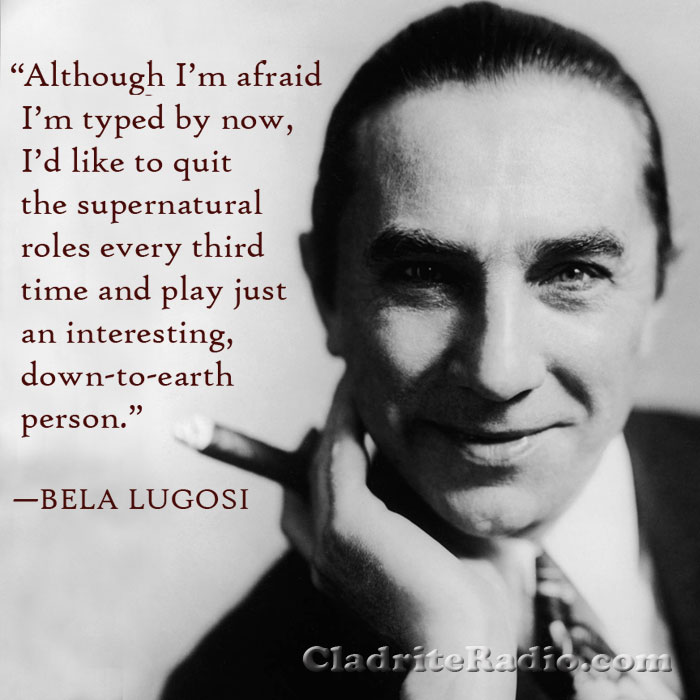Here are 10 things you should know about Bela Lugosi, born 139 years ago today. He became frustrated at being typecast in sinister roles, expressing the desire to “play just an interesting, down-to-earth person.”
Tag: Béla Ferenc Dezsõ Blaskó
Happy 134th Birthday, Bela Lugosi!
Bela Lugosi was born Béla Ferenc Dezső Blaskó in Lugos, Kingdom of Hungary (now Lugoj, Romania), not far from Transylvania, 134 years ago today. Here are 10 BH Did-You-Knows:
- Lugosi was the youngest of four children; his father was a banker. He dropped out of school at age 12 and began acting, playing small roles in regional theatre, just after the turn of the 20th century. He moved to Budapest in 2011 and began working (though still limited to minor roles) with the National Theatre of Hungary.
- Lugosi volunteered to serve in the Austro-Hungarian Army during World War I; he served in the infantry, rising to the rank of captain in the ski patrol. He was injured three times.
- Coming under scrutiny for his activism in creating an actor’s union in Hungary during the 1919 revolution, Lugosi fled the country, first to Vienna and later to Berlin. He soon came to the United States, landing in New Orleans in December 1920 as a member of the crew on a merchant ship.
- Lugosi appeared in 12 motion pictures in Hungary 1917 and ’18 and in several more in Germany. Once in the United States, he made his way to New York, where he became active in Hungarian theatre. He made his Broadway debut in 1922 in the play The Red Poppy. His American film debut came in 1923 in The Silent Command. He would soon make several other pictures, all filmed in and around NYC.
- In 1927, Bela Lugosi was cast as Count Dracula in the Broadway production of a play adapted from Bram Stoker‘s novel. Lugosi was a sensation in the role, but he was not the top choice for the role of the Count as the play was being developed as a movie. Director Tod Browning hoped to cast Lon Chaney, a much bigger name than Lugosi and someone Browning had worked with frequently, in the role, but Chaney’s tragic death opened the door for Lugosi to play the role he’d made famous in the legitimate theatre.
- The film was a great success, and Lugosi soon realized that the role of Count Dracula was both a blessing and a curse, as he found himself quickly—and permanently—typecast as a horror star.
- Lugosi, who had worked to establish an actor’s union in Hungary, was one of the organizers of the Screen Actor’s Guild (he was member no. 28).
- Lugosi was married five times, with only one of the marriages lasting more than three years (Lugosi and his fourth wife, Lillian Arch, remained together for just over twenty years). His third marriage, to a wealthy San Francisco widow named Beatrice Weeks, ended after just a few days when Weeks discovered he was carrying on an affair with actress Clara Bow.
- By the late 1930s, Lugosi, who suffered from sciatic neuritis, was addicted to the painkillers morphine and methadone. He would struggle with his dependency on these drugs for the rest of his life, and his career would suffer because of it.
- Though a rumor persisted of a feud between Lugosi and fellow horror star Boris Karloff, both men’s children insisted that, though the two men weren’t close, there were no hard feelings between them. The two actors appeared in seven films together: The Black Cat (1934), The Raven (1935), The Invisible Ray (1936), Son of Frankenstein (1939), You’ll Find Out (1940), Black Friday (1940) and The Body Snatcher (1945).
Happy birthday, Bela Lugosi, wherever you may be!

Happy 133rd Birthday, Bela Lugosi!
It’s interesting to consider how sad a figure Bela Lugosi—born Béla Ferenc Dezsõ Blaskó 133 years ago to day in Lugos, Kingdom of Hungary (now Lugoj, Romania)—remains in the minds of so many today. After all, he enjoyed a long and largely successful acting career, enjoying stage success first in his native land and later in the United States.
He appeared in his first film in Hungary in 1917, but soon thereafter emigrated to Germany (where he made a few more films) before finally arriving in the U.S.
His acting career began just after the turn of the 20th century in provincial theatres before he moved to Budapest in 1911. There, he worked with the National Theatre of Hungary from 1913-1919 (with some time off to serve as an infantryman in the Austro-Hungarian Army in the First World War).
A union activist, he felt at risk in Hungary during the Hungarian Revolution of 1919, so he left first for Vienna before settling in Berlin, where he continued to act. Eventually, he took an assignment as a merchant marine and made his way first to New Orleans and then to New York, where he underwent legal immigration inspection at Ellis Island in 1921.
In New York, Lugosi formed a stock company with a group of fellow Hungarians that toured the East Coast. He made his Broadway debut in 1922 and continued to work on the Great White Way for several years.
Lugosi first did film work in Hungary, and continued to appear in films in Berlin. His first American film work (he had previously appeared in movies in both Hungary and Germany) was in a 1923 melodrama called The Silent Command (and if you can believe it, he appeared in 48 pictures, all totaled, before Dracula).
In 1927, Lugosi was cast in the role that would prove a blessing and a curse for the rest of his life in a Broadway production of Dracula, based on the Bram Stoker novel. The production ran for 261 performances before touring the country, and the acclaim Lugosi received in the role of the bloodthirsty count led to him being offered the same role in the Tod Browning picture (though it’s said in some circles that he wasn’t the first choice for the role; rumors have long had it that Lon Chaney was originally slated for the role before his premature death in 1930).
Dracula rocketed Lugosi to stardom, but thereafter he found it difficult to get any roles outside the horror genre. Not that he didn’t pursue non-horror roles—he did, in earnest—but they were not forthcoming, and by the mid-1930s, when horror films became less of a focus at Universal Studios, Lugosi found himself assigned to the studio’s non-horror B unit, which led to small roles in lesser pictures. As a result, he frequently accepted leading roles in low-budget thrillers produced by Poverty Row companies, roles that helped pay the bills but did little to broaden the range of roles to which he was suited in the eyes of producers and the moviegoing public.
To make it worse, Lugosi suffered badly with sciatica, which doctors treated with morphine and, later, methadone. So he endured a lengthy battle with addiction to those medications, and when news spread of his reliance on painkillers, his career suffered even more.
By the 1950s, Lugosi was reduced to playing the villain in very low-budget comedies (Bela Lugosi Meets a Brooklyn Gorilla) and the even lower-budget unintentional comedies churned out by legendary (if inept) auteur Edward D. Wood, Jr. Finally, on August 16, 1956, Lugosi’s heart gave out.
Lugosi seemed a goodhearted sort, and one certainly wishes his career (and personal life—he was married five times) had worked out more to his favor, but his pictures continue to bring joy (and chills) to movie lovers today (TCM is teaming with Fathom Events to screen Dracula, in a double bill with Universal’s Spanish language version of that film, starring Carlos Villarías, in theatres around the country on October 25th and 28th). That’s a legacy that anyone might envy.

